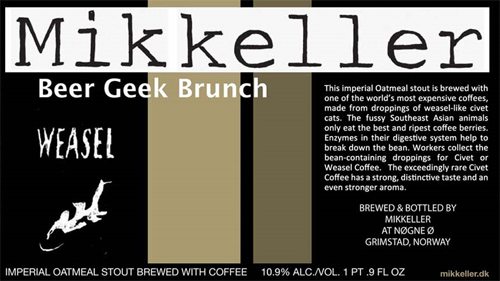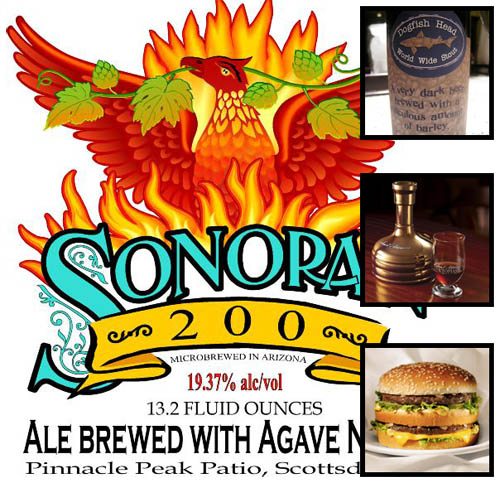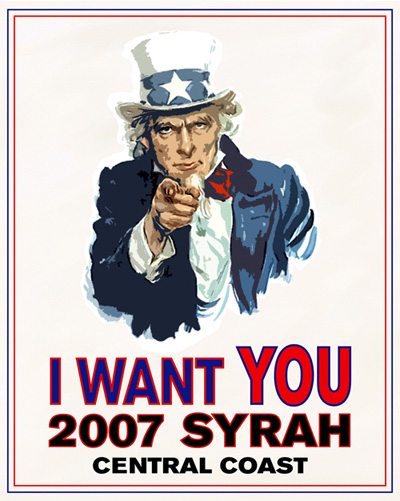There are plenty of beers with jalapeno-type peppers. Cave Creek Chili Beer goes back at least 17 years. Here is an early approval, and a recent one. But we think beers with peppercorn-type peppers are less common. Here are two. Allagash is practically a meal because it’s made with grain, sweet potatoes and black pepper. Lip Stinger is Ale Fermented with Peppercorn.
Continue Reading Leave a CommentBeer with Civet Droppings

Flying Dog has their “Good Beer, No Sh*t” Road Dog Porter as chronicled here. The Dog is not to be outdone by the Weasel. Whereas Road Dog, apparently, has no sh*t whatsoever, this ingredient is the centerpiece of Mikkeller Beer Geek Brunch. It is made with weasel excrement. Literally. The label explains that:
This imperial Oatmeal stout is brewed with one of the world’s most expensive coffees, made from droppings of weasel-like civet cats. The fussy Southeast Asian animals only eat the best and ripest coffee berries. Enzymes in their digestive system help to break down the bean. Workers collect the bean-containing droppings for Civet or Weasel Coffee. The exceedingly rare Civet Coffee has a strong, distinctive taste and an even stronger aroma.
Lest you be scared away by the “droppings,” here is at least one connoisseur who can vouch for it.
Continue Reading Leave a CommentTags: ingredients, processing, would you drink it?
Forty Proof Beer

Once upon a time, the federal government prohibited the disclosure of alcohol content on malt beverage labels. The rationale was to protect public health by discouraging brewers from competing in “strength wars,” to sell more product. It took years of persistence by Coors Brewing Company and a ruling from the Supreme Court in 1995 to persuade TTB (then ATF) to allow the practice. Did the strength wars ever materialize, once the rules changed? Among the major brewers, not really. In fact, we noted that there is war of a different kind — increasingly lighter beers (in alcohol and caloric content) from Anheuser-Busch and MillerCoors. But the craft beer movement appears to have its own strength war. “Extreme beers” — beers with intense flavors and alcohol contents at three, four or even five times the amounts in a typical American lager — help small brewers stand out in an increasingly crowded marketplace. And yes, they have many more calories too. Boston Beer Company offers one of the strongest beers available for sale in the United States, with their Utopias, at 24% alc./vol. and a whopping 732 calories per 12 ounce serving (as per Skilnik). Dogfish Head Craft Brewery’s 2002 release of World Wide Stout is listed at 23.04% alc./vol. and has approximately 666 calories per 12...
Continue Reading Leave a CommentStriking Syrah

The imagery is still striking, after all these years. Don’t you think? So much so, I am surprised that lots of alcohol beverage companies have not used this image in the past. It is also surprising that there is no TTB or other prohibition on the use of this famous image. The Library of Congress explains that the poster goes all the way back to 1916 and may be the most famous poster in the world. (More famous than Farrah?) It was used to recruit soldiers for World War I and World War II. The original poster shows “Uncle Sam,” the “national personification of the United States and sometimes more specifically of the United States government.” The wine is produced by Oreana Wine Company in Santa Barbara, California. For another, almost as famous poster used to support World War II, Rosie the Riveter is here (now in support of Oregon Dry Rosé).
Continue Reading Leave a CommentTags: design
Energy Not Allowed

You can Google “energy vodka” or “energy beer” and find millions of links in each case. But you won’t find much by way of references to “energy” on TTB-regulated labels. TTB seems to be dead-set against allowing this term, almost without regard to the context. Edison Light Beer illustrates this. The product does not even contain caffeine or other stimulants. The label does, however, make a passing reference to “energy,” saying: “Edison brings new energy to light.” Or at least it did. TTB banished the term in this March 2007 temporary approval. By the time of this March 2008 replacement approval, Edison’s energy was dissipated without a trace.
Continue Reading Leave a Comment

